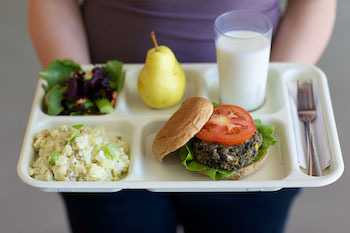
Study: School Meals Improve Under Post-2010 Standards
April 23, 2019
The School Nutrition and Meal Cost Study (SNMCS) is an important study as it is the first comprehensive and nationally representative study of school meal programs since the Healthy, Hunger-Free Kids Act of 2010. According to the study, it is unique for three main reasons:
No previous national study of the school meal programs has
- simultaneously examined the nutritional quality of school meals and the cost of producing those meals;
- assessed students’ acceptance of school meals in a quantitative way, using data on the amount of food students waste (plate waste); or
- examined associations between major outcomes of interest, for example, the association between the nutritional quality of school meals and student participation and the association between the cost and nutritional quality of school meals.

Study: School Meals Improve Under Post-2010 Standards
April 23, 2019
The School Nutrition and Meal Cost Study (SNMCS) is an important study as it is the first comprehensive and nationally representative study of school meal programs since the Healthy, Hunger-Free Kids Act of 2010. According to the study, it is unique for three main reasons:
No previous national study of the school meal programs has
- simultaneously examined the nutritional quality of school meals and the cost of producing those meals;
- assessed students’ acceptance of school meals in a quantitative way, using data on the amount of food students waste (plate waste); or
- examined associations between major outcomes of interest, for example, the association between the nutritional quality of school meals and student participation and the association between the cost and nutritional quality of school meals.
The study had numerous valuable findings in these key areas including:
Nutritional Quality of School Meals:
- The study used the Healthy Eating Index (HEI) to examine the nutritional quality of school lunches served through the National School Lunch Program (NSLP) and found that the nutrition quality of these lunches increased significantly between SY 2009–2010 and SY 2014–2015.
- This suggests that updated nutrition standards for school meals have had a positive and significant influence on nutritional quality of school meals.
- The largest increases were observed for the whole grains, greens and beans components.
- The nutritional quality of School Breakfast Program (SBP) breakfasts also increased significantly between SY 2009–2010 and SY 2014– 2015.
- The largest increases for school breakfasts were observed for whole grains and whole fruit.
- Concentrations of refined grains, empty calories, and sodium in SBP breakfasts decreased over time.
Student Acceptance (Plate Waste):
- Overall, plate waste in NSLP lunches was highest for vegetables—an average of 31 percent of the vegetables on observed lunch trays was wasted.
- For each type of food, elementary schools had a higher mean proportion of food wasted than in middle or high schools. One factor of these differences is the use of the offer-versus-serve (OVS) option, which is mandatory for high schools.
Dietary Intake:
- Lunches consumed by NSLP participants had higher concentrations of vegetables, whole grains, and dairy and lower concentrations of refined grains and empty calories than lunches consumed by matched nonparticipants.
- There was no significant positive association between the nutritional quality of NSLP lunches and the nutritional quality of the overall diets of students who consumed the lunches.
Meal Cost:
- In SY 2014–2015, reported costs of producing a reimbursable meal in most school food authorities (SFAs) exceeded the Federal subsidies for free meals.
- On average, revenues from reimbursable lunches covered only an average of 93 percent of reported costs of producing those meals, and revenues from SBP breakfasts covered an average of 82 percent of reported costs.
- Mean reported costs per NSLP lunch were not significantly higher in schools that prepared more nutritious meals.
Student Participation:
- There was a positive and statistically significant association between student participation in the NSLP and the nutritional quality of NSLP lunches.






